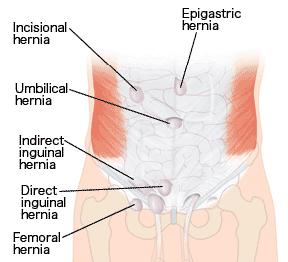Femoral Hernia

Femoral Hernia
Human muscles and tissues are strong enough to hold your intestines in place. But if there is some weaker points, the intestine may bulge through these points and this is know as hernia. Bulging of tissues from lower belly to below the groin crease near the upper thigh is known as femoral hernia. Primary symptom of femoral hernia is the pain experienced in the groin and this is usually mistaken as inguinal hernia.
Diagnosis of femoral hernia is very difficult as it is very small in size and even your doctor may not be able to identify it. Sometimes the intestine involved in hernia may get trapped causing obstruction to the blood flow. This is known as strangled hernia.Surgical removal is the only remedy for femoral hernia. Usually femoral hernia is removed through a laparoscopic surgery.
Causes
These hernias may appear due to some strain experienced on the abdomen in activities like straining in the toilet when you have constipation. Pushing heavy objects, persistent cough, obesity etc also can be reasons for the formation of femoral hernia.
When surgery is needed?
Though surgical correction is the only possible solution to femoral hernia, surgeons do not promote it as there are many risk factors involved in this surgery. Some of them are discussed below.
- Bowel may get stuck in femoral canal resulting in stomach pain, and vomiting.
- when bowel is trapped its blood supply is stopped which necessitates
emergency surgeries to protect them from destruction.
Surgical procedure
In laparoscopic procedure three or four small incisions are made at suitable places in the abdomen through which the laparoscope and other surgical instruments are inserted. Surgeon performs the surgery by viewing the organs involved in the operation with the help of videos taken by the laparoscope which are displayed in a monitor placed before him. He pushes back the protruding small intestine to its original place and the weaker portions through which the bulge occurred are strengthened by placing a synthetic mesh over there so that the did not bulge again.
Risks factors after the surgery
- A lump may develop under the wound
- Difficulty may be experienced in urine passing
- Bowel injuries may be caused
- Injury to nerves resulting in pain and numbness
OUR TEAM

Dr. Nagaraj B Puttaswamy
Senior Consultant - Laparoscopic Surgeon Bariatric Surgeon and Surgical Gastroenterologist


